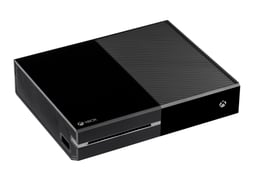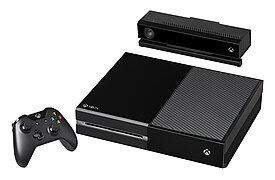Xbox
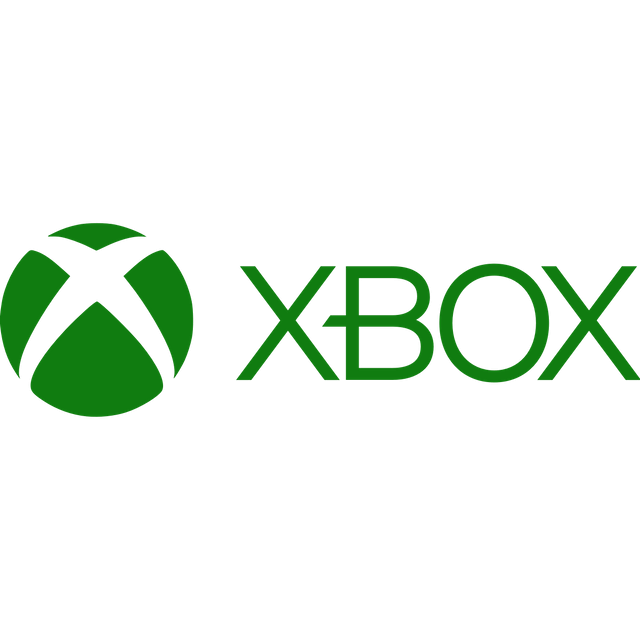
Xbox

| Product type | Video gaming |
|---|---|
| Owner | Microsoft |
| Country | Microsoft Redmond Campus, Redmond, Washington, United States |
| Introduced | November 15, 2001 (2001-11-15) |
| Markets | Worldwide |
| Registered as a trademark in | Worldwide |
| Website | www.xbox.com [86] |
Xbox is a video gaming brand created and owned by Microsoft. It represents a series of video game consoles developed by Microsoft, with three consoles released in the sixth, seventh, and eighth generations, respectively. The brand also represents applications (games), streaming services, an online service by the name of Xbox Live, and the development arm by the name of Xbox Game Studios. The brand was first introduced in the United States in November 2001, with the launch of the original Xbox console.
The original device was the first video game console offered by an American company after the Atari Jaguar stopped sales in 1996. It reached over 24 million units sold as of May 2006.[1] Microsoft's second console, the Xbox 360, was released in 2005 and has sold 84 million units as of June 2014. The Xbox One has been released in 21 markets in total, with a Chinese release in September 2014. The head of Xbox is Phil Spencer, who succeeded former head Marc Whitten in late-March 2014.[2][3]
| Product type | Video gaming |
|---|---|
| Owner | Microsoft |
| Country | Microsoft Redmond Campus, Redmond, Washington, United States |
| Introduced | November 15, 2001 (2001-11-15) |
| Markets | Worldwide |
| Registered as a trademark in | Worldwide |
| Website | www.xbox.com [86] |
Consoles
Xbox
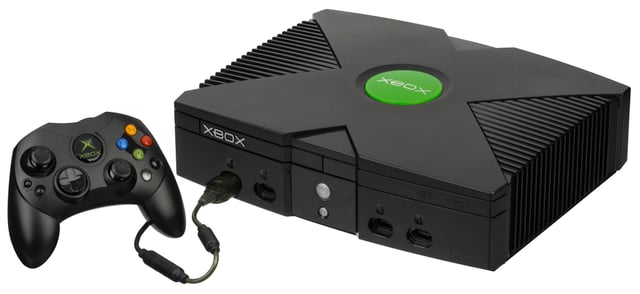
Xbox console with "Controller S"
The original Xbox was released on November 15, 2001, in North America, February 22, 2002, in Japan, and March 14, 2002, in Australia and Europe. It was Microsoft's first foray into the gaming console market. As part of the sixth-generation of gaming, the Xbox competed with Sony's PlayStation 2, Sega's Dreamcast (which stopped American sales before the Xbox went on sale), and Nintendo's GameCube. The Xbox was the first console offered by an American company after the Atari Jaguar stopped sales in 1996. The name Xbox was derived from a contraction of DirectX Box, a reference to Microsoft's graphics API, DirectX.[4][5]
The integrated Xbox Live service launched in November 2002 allowed players to play games online with or without a broadband connection.[6] It first competed with Dreamcast's online service but later primarily competed with PlayStation 2's online service. Although these two are free while Xbox Live required a subscription, as well as broadband-only connection which was not completely adopted yet, Xbox Live was a success due to better servers, features such as a buddy list, and milestone titles like Halo 2 released in November 2004, which is the best-selling Xbox video game and was by far the most popular online game for the system.
Xbox 360
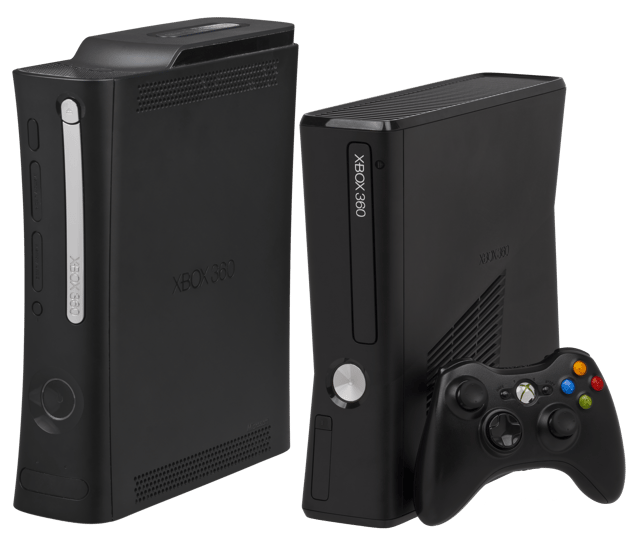
Xbox 360 Elite, Right: Xbox 360 S and new-style controller
The Xbox 360 was released as the successor of the original Xbox in November 2005, competing with Sony's PlayStation 3 and Nintendo's Wii as part of the seventh generation of video game consoles. As of June 30, 2013, 78.2 million Xbox 360 consoles have been sold worldwide.[7] The Xbox 360 was officially unveiled on MTV on May 12, 2005, with detailed launch and game information divulged later that month at the Electronic Entertainment Expo (E3). The console sold out completely upon release in all regions except in Japan.[8][9][10]
The Xbox 360 showed an expanded Xbox Live service (which now included a limited "Free" tier called Silver), the ability to stream multimedia content from PCs, while later updates added the ability to purchase and stream music, television programs, and films through the Xbox Music and Xbox Video services, along with access to third-party content services through third-party media streaming applications. Microsoft also released Kinect, a motion control system for the Xbox 360 which uses an advanced sensor system.
At their E3 presentation on June 14, 2010, Microsoft announced a redesigned Xbox 360 that would ship on the same day.[11] The redesigned console is slimmer than the previous Xbox 360 model and features integrated 802.11 b/g/n Wi-Fi, TOSLINK S/PDIF optical audio output, five USB 2.0 ports (compared to the three from older versions) and special port designed for the Kinect peripheral.[12] Older models of the Xbox 360 have since been discontinued.[13] The first new console to be released features a 250 GB hard drive, while a later less expensive SKU features 4 GB internal storage.
Xbox One
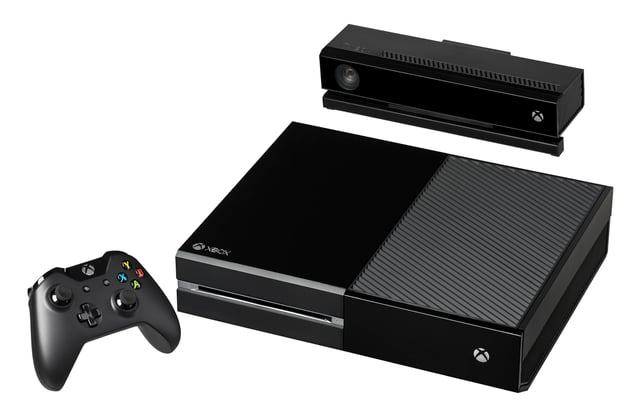
The Xbox One with the redesigned Kinect and controller
The Xbox One was released on November 22, 2013, in North America, as the successor of the Xbox 360. The Xbox One competes with Sony's PlayStation 4 and Nintendo's Wii U and Switch as part of the eighth generation of video game consoles.
Announced on May 21, 2013,[14] the Xbox One has an emphasis on internet-based features, including the ability to record and stream gameplay, and the ability to integrate with a set-top box to watch cable or satellite TV through the console with an enhanced guide interface and Kinect-based voice control.[15][16][17][18]
Following its unveiling, the Xbox One proved controversial for its original digital rights management and privacy practices; while Microsoft touted the ability for users to access their library of games (regardless of whether they were purchased physically or digitally) on any Xbox One console without needing their discs, and the ability to share their entire library with 10 designated "family" members, all games would have to be tied to the user's Xbox Live account and their Xbox One console, and the console would be required to connect to the Internet on a periodic basis (at least once every 24 hours) to synchronize the library, or else the console would be unable to play any games at all.[19][20] After an overwhelmingly negative response from critics and consumers (who also showed concerns that the system could prevent or hinder the resale of used games), Microsoft announced that these restrictions would be dropped.[21] Microsoft was also criticized for requiring the Xbox One to have its updated Kinect peripheral plugged in to function, which critics and privacy advocates believed could be used as a surveillance device. As a gesture toward showing a commitment to user privacy, Microsoft decided to allow the console to function without Kinect.[22][23][24]
On June 13, 2016, Microsoft announced the Xbox One S, a slimmer version of the Xbox One, at E3 2016.[25] Phil Spencer, head of Xbox, announced Project Scorpio at E3 2016 on June 13, 2016, an addition to the Xbox One family, saying it would release in Holiday 2017.[26] At E3 2017, Microsoft revealed the final name of the console to be Xbox One X, and that it would start shipping worldwide on November 7, 2017 for a final retail price of $499.[27]
Comparison
| Xbox | Xbox 360 | Xbox One | Xbox One S | Xbox One X | |
|---|---|---|---|---|---|
| Console |  |  |  | ||
| Console Launch price |
|
|
|
| US$499.99 (Black 1 TB version) |
| Release date |
|
|
| Xbox One S: August 2, 2016 Xbox One S All-Digital Edition: May 7, 2019 |
|
| Discontinued |
|
|
| N/A | N/A |
| Units sold | 24+ million (as of May 10, 2006)[1] | 77.2 million (as of April 18, 2013)[29](details) | 26+ million (estimate, as of January 18, 2017)[30] | N/A | |
| Best-selling game | Halo 2, 8 million (as of May 9, 2006)[31][32] | Kinect Adventures! (pack-in with Kinect peripheral),24 million[33]Best selling non-bundled game: Call of Duty: Modern Warfare 3, 14.23 million[34] | Call of Duty: Black Ops III, 7.24 million (As of October 16, 2016)[35] | ||
| Media | CD, DVD | CD, DVD, HD DVD (movies only) with add-on drive, USB Drive with supported media, DLNA Servers[36] | CD, DVD, Blu-ray Disc, USB Drive with supported media, DLNA Servers[36] | CD, DVD, Blu-ray Disc, UHD Blu-ray Disc, USB Drive with supported media, DLNA Servers[37] | |
| Accessories (retail) |
| see Xbox 360 accessories |
| ||
| CPU | 733 MHz x86 Intel Celeron/Pentium III Custom Hybrid CPU | 3.2 GHz IBM PowerPC tri-core CPU codenamed "Xenon" | 1.75 GHz AMD x86-64 eight-core CPU codenamed "Jaguar"[38] | 2.3 GHz semi-custom AMD x86-64 eight-core CPU code named "Jaguar Enhanced"[37] | |
| GPU | 233 MHz nVidia custom GeForce 3 NV2A DirectX 8.0 based GPU | 500 MHz ATi custom Radeon X1800 DirectX 9.0c based GPU codenamed "Xenos" | 853 MHz AMD Radeon HD 7000 series DirectX 11.1, DirectX 12 based GPU codenamed "Durango" with 12 compute units | 914 MHz AMD Radeon HD 7000 series DirectX 11.1, DirectX 12 based GPU codenamed "Edmonton" with 12 compute units | 1172 MHz AMD GCN DirectX 11.1, DirectX 12 based GPU codenamed "Scorpio" with 40 compute units |
| Memory | 64 MB DDR SDRAM @ 200 MHz 6.4 GB/s | 512 MB of GDDR3 RAM @ 700 MHz 22.4 GB/s, 10 MB EDRAM GPU frame buffer memory | 8 GB of DDR3 RAM @ 2133 MHz 68.3 GB/s,[36] 32 MB ESRAM GPU frame buffer memory | 12 GB of GDDR5 RAM @ 6.8 GHz 326 GB/s[37] | |
| Video I/O ports |
|
|
|
| |
| Video Resolution and Features |
|
|
| ||
| Video Codecs supported | ??? |
|
| ||
| Audio I/O |
|
|
|
| |
| Audio Formats and Features |
|
|
| ||
| Audio Codecs supported | ??? |
|
| ||
| Online service | Xbox Live (2002–10) XLink Kai (2003-present) | Xbox Live Xbox Live Arcade Xbox Live Marketplace Xbox Live Vision (webcam), headset Xbox Live Video Marketplace Windows Live Messenger Internet Explorer VideoKinect (Kinect sensor is no longer needed) | Xbox Live Xbox Store Internet Explorer Microsoft Edge Skype | ||
| Backward compatibility | N/A | 50% of Xbox Library | Select Xbox 360 and Xbox titles[39] | ||
| System software | Xbox Music Mixer DVD Playback Kit, Xbox Linux | see Xbox 360 system software | see Xbox One system software | ||
| System software features |
|
|
|
| |
| Consumer programmability | Via Softmods and/or modchips; Modified Windows CE 2.x, Linux. | Development on PC with XNA Game Studio ($99/year subscription, binary distribution with XNA 1.0 Refresh).[42] | ID@Xbox and approved Microsoft Store; UWP apps. | ||
Future console
During its E3 2019 press conference, Microsoft announced "Project Scarlett", a next-generation Xbox console featuring AMD's "Zen 2" CPU architecture and Radeon "RDNA" graphics architecture, a custom-designed solid state drive, GDDR6 SDRAM, and support for real-time ray-tracing, up to 120 frames per second rendering, and 8K resolution. Microsoft stated that "Scarlett" would be four times as powerful as Xbox One X. Spencer committed to continue supporting the physical distribution of games on discs on Scarlett. Halo Infinite was stated to be a launch title for the console.[43][44][45] Microsoft stated that Scarlett would support existing Xbox One titles, as well as Xbox and Xbox 360 titles that it had made compatible with Xbox One; as to make this goal, Microsoft also affirmed that it was stopping any further addition of new titles to the backward compatibility program in order to focus on Scarlett's backwards compatibility.[46][47] All existing Xbox One accessories are also expected to be compatible with Scarlett.[48]
Games
Each console has a variety of games. Most games released on the original Xbox are backwards compatible and can be played directly on its successor, Xbox 360. Backward compatibility with Xbox 360 titles was added to Xbox One in June 2015, although titles requiring Kinect or USB peripherals will not be supported.
Online services
Xbox Live
Xbox Live is an online service with over 65 million users worldwide (as of July 2019).[49] It comprises an online virtual market, the Xbox Live Marketplace, which allows the purchase and download of games and various forms of multimedia. Online gaming on the Xbox first started on November 15, 2002 worldwide. The service is still active and continues to be played by gamers.
Xbox Live Marketplace
The Xbox Live Marketplace (XBLM) is a virtual market designed for Microsoft's Xbox 360 console that allows Xbox Live members to download purchased or promotional content. The service offers movie and game trailers, Video Store, game demos, Xbox Live Arcade games, Xbox Live Indie Games (Previously Community Games), Games on Demand (Xbox 360 and Xbox Originals), downloadable content such as map packs, gamer pictures, and Xbox 360 Dashboard themes.
The August 11, 2009 update added Xbox 360 games for download, the Avatar Marketplace, and renamed Community Games to Indie Games.
The Spring 2007 update to the Xbox 360 Dashboard relocated the Marketplace to its own "blade" in order to bring more attention to the service and make it more accessible to users. Although this has been obsoleted by the NXE update, the section has been implemented into three separate sections in the Dashboard: the Game Marketplace, Video & Music Marketplace, and Avatar Marketplace.
Downloaded content requires enough space on either the Xbox 360's hard drive, or an Xbox 360 Memory Unit. Selected downloads are placed in a queue and are downloaded whilst the console is powered on and is connected to Xbox Live. Users can choose to send certain downloads to the front of the queue to be downloaded first. Downloads are temporarily halted during certain times where games make use of Xbox Live's features (e.g. online multiplayer).
Xbox SmartGlass
Xbox SmartGlass is a companion application for Xbox 360 available for Windows 8, Windows 10, Windows Phone, iOS, Android (version 4.0 and above),[50] and Windows Server 2012. It was announced by Microsoft during E3 2012 and released on October 26, 2012, coinciding with the release of Windows 8.[51] It connects with the Xbox 360 and allows more interactive entertainment, allowing mobile devices to potentially serve as second screens and remote controller. Currently Windows 8 and Windows RT Tablets and PCs, Windows Phone (7.5 and 8) iOS devices, and Android smartphones (4.x) are compatible with SmartGlass,[52] providing information such as Halo 4 stats and Forza Horizon GPS.[53] Users of Windows Server 2012 can currently download the application from the Windows Store after installing the Windows Desktop Experience feature in the Server Manager.[54]
Gaming Cloud
Gaming Cloud is a division within Microsoft's Xbox team to help game developers incorporate their cloud computing elements, such as Microsoft Azure within their games. While focused on Xbox and Windows games, the division will support developers regardless of target platform or distribution channel. The division was formed in March 2018, and led by Kareem Choudhry.[55][56]
Software
Xbox 360 Dashboard
The Xbox 360's original graphical user interface was the Xbox 360 Dashboard; a tabbed interface that featured five "Blades" (formerly four blades), and was designed by AKQA and Audiobrain. It could be launched automatically when the console booted without a disc in it, or when the disc tray was ejected, but the user had the option to select what the console does if a game is in the tray on start up, or if inserted when already on. A simplified version of it was also accessible at any time via the Xbox Guide button on the gamepad. This simplified version showed the user's gamercard, Xbox Live messages and friends list. It also allowed for personal and music settings, in addition to voice or video chats, or returning to the Xbox Dashboard from the game.
Xbox One Dashboard
Controllers
Xbox Controller
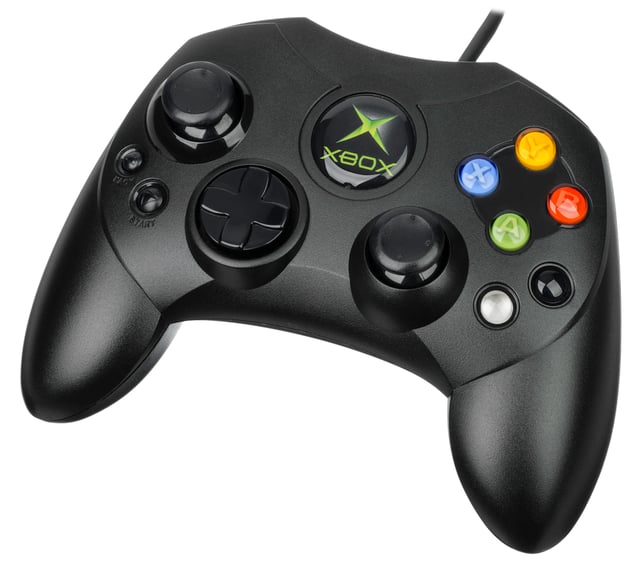
Xbox Controller S, which first shipped in 2002

Original Xbox controller, first showcased in 2000
Released in 2001, the Xbox control pad was the first controller made for the original Xbox. The Xbox controller features two analog sticks, a pressure-sensitive directional pad, two analog triggers, a Back button, a Start button, two accessory slots and six 8-bit analog action buttons (A/Green, B/Red, X/Blue, Y/Yellow, and Black and White buttons).[57] The standard Xbox controller (originally nicknamed the "Fatty"[58] and later the "Duke"[59]) was originally the controller bundled with Xbox systems for all territories except Japan.
Xbox 360 Controller
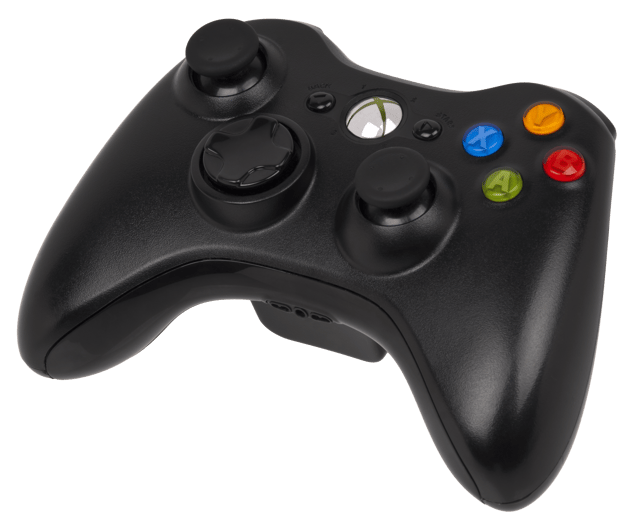
Xbox 360 S Controller
Released in 2005, the Xbox 360 controller for the Xbox 360 succeeded its predecessor. A standard Xbox 360 controller features eleven digital buttons, two analog triggers, two analog sticks and a digital D-pad. The right face of the controller features four digital action buttons; a green "A" button, red "B" button, blue "X" button and yellow "Y" button. The lower right houses the right analog stick, in lower left is a digital D-pad and on the left face is the left analog stick. Both analog sticks can also be "clicked in" to activate a digital button beneath. In the center of the controller face are digital "Start", "Back" and "Guide" buttons. The "Guide" button is labelled with the Xbox logo, and is used to turn on the console/controller and to access the guide menu. It is also surrounded by the "ring of light", which indicates the controller number, as well as flashing when connecting and to provide notifications. The left and right "shoulders" each feature a digital shoulder button, or "bumper", and an analog trigger.
Xbox 360 Kinect
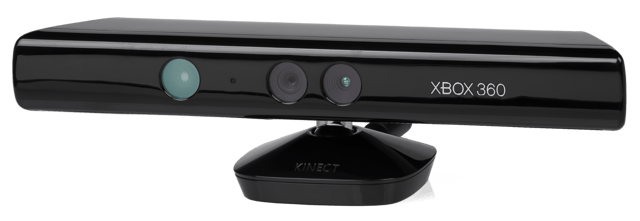
The Xbox 360 Kinect Sensor
Kinect (stylized as KINECT) is a motion sensing input device by Microsoft for the Xbox 360 video game console and Windows PCs. Based around a webcam-style add-on peripheral for the Xbox 360 console, it enables users to control and interact with the Xbox 360 without the need to touch a game controller, through a natural user interface using gestures and spoken commands.[60] The project is aimed at broadening the Xbox 360's audience beyond its typical gamer base.[61] Kinect competes with the Wii Remote Plus and PlayStation Move with PlayStation Eye motion controllers for the Wii and PlayStation 3 home consoles, respectively. A version for Windows was released on February 1, 2012.[62]
Kinect was launched in North America on November 4, 2010,[63] in Europe on November 10, 2010,[64] in Australia, New Zealand and Singapore on November 18, 2010,[65][66][67] and in Japan on November 20, 2010.[68] Purchase options for the sensor peripheral include a bundle with the game Kinect Adventures and console bundles with either a 4 GB[69][70][71] or 250 GB[72] Xbox 360 console and Kinect Adventures.[69][70][71][72]
Additional information on the Xbox One Kinect was released on June 6, 2013, including information on how to turn off the "always on" feature.[81]
Xbox One Controller
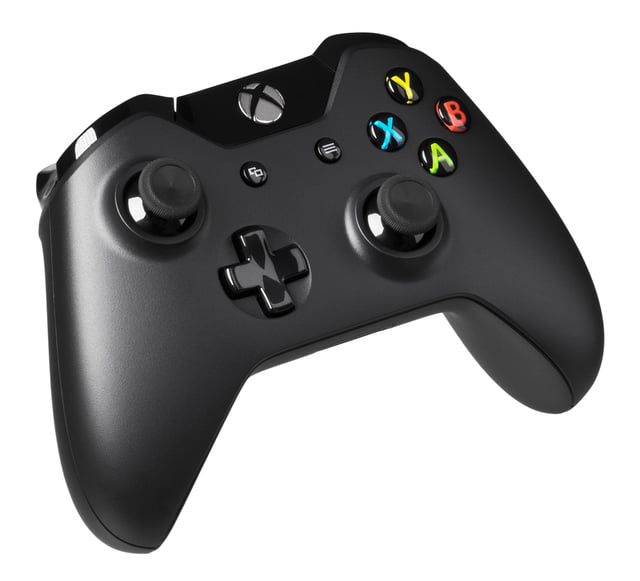
Xbox One Controller
The Xbox One console has a revised controller with forty improvements over the 360's controller. This new controller is built to work with Kinect. The Start and Back buttons are replaced with Menu and View buttons. It has impulse triggers that replace the regular triggers. The button with the Xbox logo will no longer bring up the Xbox Guide as the Xbox Guide Button on the Xbox 360 controller did. The button will now open up the dashboard without interrupting the game currently being played by the user. Once pressed again, the Xbox will resume the game.[82]
Xbox One Kinect
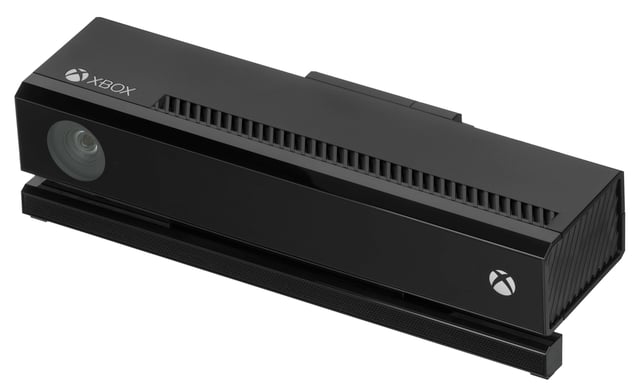
The Xbox One Kinect sensor
Although featuring improved performance over the original Kinect, its successor has been subject to mixed responses. It has been praised for its wide angle, its fast response time and high quality camera. However, the Kinect's inability to understand some accents in English was criticized. Furthermore, controversies surround Microsoft's intentional tying of the sensor with the Xbox One console despite the initial requirements for the sensor being plugged in at all times having been revised since its initial announcement. There have also been a number of concerns regarding privacy.

